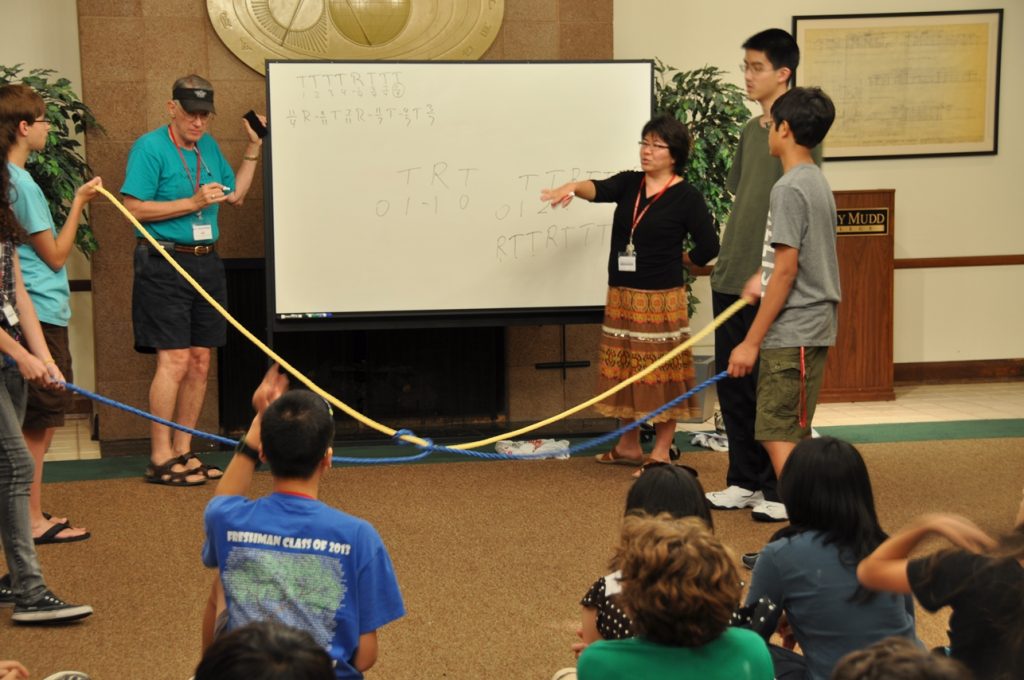John H Conway was a great mathematician active in finite groups, knot theory, number theory, combinatorial game theory, and much more. He made great contributions to recreational mathematics, especially the invention of the Game of Life (see our blog post about Conway’s Game of Life). One particular activity at Areteem’s math camps is Conway’s Rational Tangles.
Rational Tangles was developed by Conway in knot theory. It involves representing a tangled knot created by two ropes with a rational number. What’s special about Rational Tangles is that it can be performed as a group activity, with four performers, one conductor, and an audience. This has been a must-have activity at many of our summer math camps as well as our training programs for math teachers from Saudi Arabia.
Here’s how it went at one of the summer camps. I asked one of the camp counselors, Michael, to be the conductor, and he selected 4 student volunteers from the audience to be the performers. Then the performers held two ropes, and stood at the four corners of a square (marked on the floor). The two in the front (close to the audience) each held an end of one rope, and the two in the rear each held an end of the other rope.
Michael explained to the audience, the current shape of the two ropes, two parallel lines (untangled), represented the number 0. There were only two allowed movements by the performers. One is “Twist”: the two performers on the left (seen from the audience) switch places, the one in the front going under the rope of the one in the rear. The other is “Rotate”: the four performers went around the marked square 90 degrees clockwise. They should hold on to the ropes in all movements. After one Twist, the ropes were tangled into a knot in the middle. Michael told the audience that this represented the number 1. So the effect of one Twist was to increase the tangle number by 1. He asked the performers to perform a few more Twists, and it was clear that the ropes became more and more tangled. So the audience agreed that each Twist indeed increased the tangle number by 1.

Then Michael asked the performers to get back to holding the ropes in the initial untangled parallel position. At this point, he told the performers to do one Twist, one Rotate, and one more Twist. The ropes magically became untangled!
So Michael asked the audience, what did the Rotate represent? One student from the audience, Alex, said since the final Twist added 1 to the then-current number and got to 0, it was obvious that before the final Twist, the tangle number was -1. So the Rotate would change a 1 to a -1, therefore Rotate must mean “Change the sign of the number”!
Michael smiled and said “Good observation! Now let’s test this hypothesis and see if it is true.” He then selected 4 more volunteers to replace the current performers, asked them to stand and hold the ropes in the initial untangled position, and told them to do 2 Twists in a row. This brought the tangle number to 2, he said to the audience. Then he asked the performers Rotate. Now, since the Rotate would change the sign, the number should be -2. So two more Twists should untangle the ropes! Now the performers did the two Twists. However, the ropes were still tangled. It looked like the Rotate was not quite a change of signs.

Then another student, Patrick, said how about negative reciprocal? The move from 1 to -1 could be not only changing a sign, but also taking a reciprocal, because 1’s reciprocal is itself. Michael said, that’s good, let’s test it again. So he asked the performers to get back to the original position again, and do 2 Twists in a row. So now it was 2. Then the performers did a Rotate. Taking the negative reciprocal of 2, it should be -1/2 now, Michael said. How do we get back to 0? Patrick said quickly: “add 1!” The performers did one Twist. Michael asked “what is the number now?” The audience said “1/2 !” Patrick then said, “how about Rotate now”? The performers did a Rotate. “What’s the number now?” “-2”. “Okay,” Michael said, “Now we do two more Twists, and we should be done, right?” He directed the performers to do two Twists. Voila! The ropes were untangled. The audience cheered and applauded.

Now Michael asked for 4 new volunteers to replace the performers. Then he rapidly shouted a series of commands to the performers, “Twist! Rotate! Twist! Twist! ….” until the ropes were tangled together in a huge knot. In the whole process, the audience kept track of all the movements and calculated the tangle numbers along the way. After verifying that everyone agreed on the number, I handed a plastic bag to Michael, so he went over to the tangled ropes, wrapped the bag around the knot, and tightened the bag.
Now it was the audience’s turn to tell the performers another series of commands, based on the tangle number at the time the knot was wrapped by the plastic bag, in an attempt to untangle it, while the ropes could not untangle before the process was over, because they were held by the plastic bag.
After all the steps were done, Michael asked Amy and Sophia, the two youngest campers, to tear the plastic bag apart. The two girls ran forward and very quickly tore the bag away. Then the performers tugged on the ropes and they came apart, completely untangled! Very loud cheers and applause erupted from the audience. It was a really fun activity and everyone was engaged and excited.
Math is fun!
Share this post!